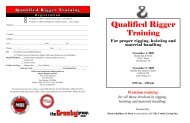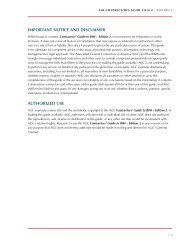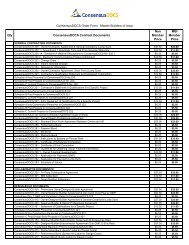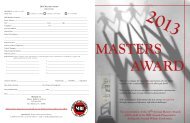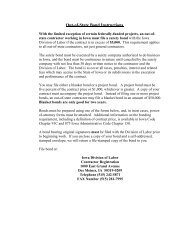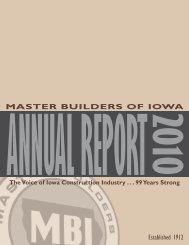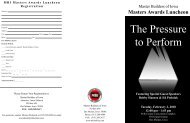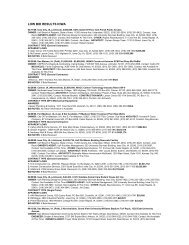Carpentry
Carpentry
Carpentry
You also want an ePaper? Increase the reach of your titles
YUMPU automatically turns print PDFs into web optimized ePapers that Google loves.
To make changes to this form, select View | Toolbars | Forms, then click the lock at the end of the toolbar. Lock<br />
the toolbar before using the checkboxes and gray areas. Type in the gray areas.<br />
Arch-Const. Cluster<br />
Area Description:<br />
Module Title / #:<br />
CARPENTRY<br />
Fundamentals – Level One<br />
Standards: 1. Demonstrate Knowledge Regarding the Construction Trade and Industry<br />
Performance 1. Describe the impact of globalization on the construction industry.<br />
2. Identify methods for productive workplace relations in a multi-cultural environment.<br />
3. Identify and describe the construction processes that relate to the function of<br />
construction systems.<br />
4. Utilize English Language Arts skills to read and interpret technical information<br />
required to be a safe and productive worker.<br />
5. Utilize a combination of measurement and mathematical processes to solve<br />
construction-related problems.<br />
6. Describe the history of the carpentry trade.<br />
7. Identify the aptitudes, behaviors, and skills needed to be a successful carpenter.<br />
8. Identify the training opportunities within the carpentry trade.<br />
9. Identify the career and entrepreneurial opportunities within the carpentry trade.<br />
10. Identify the responsibilities of a person working in the construction industry.<br />
11. State the personal characteristics of a professional.<br />
12. Explain the importance of safety in the construction industry.<br />
Standards: 2. Demonstrate Knowledge of Building Materials, Fasteners, and Adhesives<br />
Performance 1. Identify various types of building materials and their uses.<br />
2. State the uses of various types of hardwoods and softwoods.<br />
3. Identify the different grades and markings of wood building materials.<br />
4. Identify the safety precautions associated with building materials.<br />
5. Describe the proper method of storing and handling building materials.<br />
6. State the uses of various types of engineered lumber.<br />
7. Calculate the quantities of lumber and wood products using industry-standard<br />
methods.<br />
8. Describe the fasteners, anchors, and adhesives used in construction work and<br />
explain their uses.<br />
Standards: 3. Use Hand and Power Tools Properly and Safely<br />
Performance 1. Identify the hand tools commonly used by carpenters and describe their uses.<br />
2. Use hand tools in a safe and appropriate manner.<br />
3. State the general safety rules for operating all power tools, regardless of type.<br />
4. State the general rules for properly maintaining all power tools, regardless of type.<br />
5. Identify the portable power tools commonly used by carpenters and describe their<br />
uses.<br />
6. Use portable power tools in a safe and appropriate manner.<br />
MBI-DE Architecture-Construction Career Cluster Standards & Benchmarks 1
Standards: 4. Read Plans and Elevations<br />
Performance 1. Describe the types of drawings usually included in a set of plans and list the<br />
information found on each type.<br />
2. Identify the different types of lines used on construction drawings.<br />
3. Identify selected architectural symbols commonly used to represent materials on<br />
plans.<br />
4. Identify selected electrical, mechanical, and plumbing symbols commonly used on<br />
plans.<br />
5. Identify selected abbreviations commonly used on plans.<br />
6. Read and interpret plans, elevations, schedules, sections, and details contained in<br />
basic construction drawings.<br />
7. State the purpose of written specifications.<br />
8. Identify and describe the parts of a specification.<br />
9. Demonstrate or describe how to perform a quantity takeoff for materials.<br />
Standards: 5. Construction Floor Systems<br />
Performance 1. Identify the different types of framing systems.<br />
2. Read and interpret drawings and specifications to determine floor system<br />
requirements.<br />
3. Identify floor and sill framing and support members.<br />
4. Name the methods used to fasten sills to the foundation.<br />
5. Given specific floor load and span data, select the proper girder/beam size from a<br />
list of available girders/beams.<br />
6. List and recognize different types of floor joists.<br />
7. Given specific floor load and span data, select the proper joist size from a list of<br />
available joists.<br />
8. List and recognize different types of bridging.<br />
9. List and recognize different types of flooring materials.<br />
10. Explain the purposes of subflooring and underlayment.<br />
11. Match selected fasteners used in floor framing to their correct uses.<br />
12. Estimate the amount of material needed to frame a floor assembly.<br />
13. Demonstrate the ability to:<br />
• Lay out and construct a floor assembly<br />
• Install bridging<br />
• Install joists for a cantilever floor<br />
• Install a subfloor using butt-joint plywood/OSB panels<br />
• Install a single floor system using tongue-and-groove plywood/OSB panels<br />
Standards: 6. Demonstrate Knowledge and Ability to Construction Walls and Ceilings<br />
Performance 1. Identify the basic principles of optimal value engineering/advanced framing.<br />
2. Identify the components of a wall and ceiling layout.<br />
3. Describe the procedure for laying out a wood frame wall, including plates, corner<br />
posts, door and window openings, partition Ts, bracing, and firestops.<br />
4. Describe the correct procedure for assembling and erecting an exterior wall.<br />
5. Identify the common materials and methods used for installing sheathing on walls.<br />
6. Lay out, assemble, erect, and brace exterior walls for a frame building.<br />
7. Describe wall framing techniques used in masonry construction.<br />
8. Explain the use of metal studs in wall framing.<br />
9. Describe the correct procedure for laying out ceiling joists.<br />
10. Cut and install ceiling joists on a wood frame building.<br />
11. Estimate the materials required to frame walls and ceilings.<br />
MBI-DE Architecture-Construction Career Cluster Standards & Benchmarks 2
Standards: 7. Demonstrate Knowledge and Ability to Construction Roof Systems<br />
Performance 1. Understand the terms associated with roof framing.<br />
2. Identify the roof framing members used in gable and hip roofs.<br />
3. Identify the methods used to calculate the length of a rafter.<br />
4. Identify the various types of trusses used in roof framing.<br />
5. Use a rafter framing square, speed square, and calculator in laying out a roof.<br />
6. Identify various types of sheathing used in roof construction.<br />
7. Frame a gable roof with vent openings.<br />
8. Frame a roof opening.<br />
9. Erect a gable roof using trusses.<br />
10. Estimate the materials used in framing and sheathing a roof.<br />
Standards: 8. Demonstrate knowledge of concrete, reinforcing materials and forming<br />
systems.<br />
Performance 1. Identify the properties of cement.<br />
2. Describe the composition of concrete.<br />
3. Perform volume estimates for concrete quantity requirements.<br />
4. Identify types of concrete reinforcement materials and describe their uses.<br />
5. Identify various types of footings and explain their uses.<br />
6. Identify the parts of various types of forms.<br />
7. Explain the safety procedures associated with the construction and use of concrete<br />
forms.<br />
8. Erect, plumb, and brace a simple concrete form with reinforcement.<br />
Standards: 9. Demonstrate Knowledge and Ability to Install Windows and Exterior Door<br />
Units<br />
Performance 1. Identify various types of fixed, sliding, and swinging windows.<br />
2. Identify the parts of a window installation.<br />
3. State the requirements for a proper window installation.<br />
4. Install a pre-hung window.<br />
5. Identify the common types of exterior doors and explain how they are constructed.<br />
6. Identify the parts of a door installation.<br />
7. Identify the types of thresholds used with exterior doors.<br />
8. Install a pre-hung exterior door.<br />
9. Identify the various types of locksets used on exterior doors and explain how they<br />
are installed.<br />
10. Install a lockset.<br />
Standards: 10. Demonstrate Knowledge and Ability to Construct Basic Stair Units<br />
Performance 1. Identify the various types of stairs.<br />
2. Identify the various parts of stairs.<br />
3. Identify the materials used in the construction of stairs.<br />
4. Interpret construction drawings of stairs.<br />
5. Calculate the total rise, number and size of risers, and number and size of treads<br />
required for a stairway.<br />
6. Lay out and cut stringers, risers, and treads.<br />
7. Build a small stair unit with a temporary handrail.<br />
MBI-DE Architecture-Construction Career Cluster Standards & Benchmarks 3
Arch-Const. Cluster<br />
Area Description:<br />
Module Title / #:<br />
CARPENTRY<br />
Framing and Finishing – Level Two<br />
Standards: 11. Read and Interpret Commercial Drawings<br />
Performance 1. Recognize the difference between commercial and residential construction<br />
drawings.<br />
2. Identify the basic keys, abbreviations, and other references contained in a set of<br />
commercial drawings.<br />
3. Accurately read a set of commercial drawings.<br />
4. Identify and document specific items from a door and window schedule.<br />
5. Explain basic construction details and concepts employed in commercial<br />
construction.<br />
6. Calculate the floor area of each room in a floor plan.<br />
Standards: 12. Demonstrate Knowledge and Ability to Install Roofing Materials<br />
Performance 1. Identify the materials and methods used in roofing.<br />
2. Explain the safety requirements for roof jobs.<br />
3. Install fiberglass shingles on gable and hip roofs.<br />
4. Close up a valley using fiberglass shingles.<br />
5. Explain how to make various roof projections watertight when using fiberglass<br />
shingles.<br />
6. Complete the proper cuts and install the main and hip ridge caps using fiberglass<br />
shingles.<br />
7. Lay out, cut, and install a cricket or saddle.<br />
8. Install wood shingles and shakes on roofs.<br />
9. Describe how to close up a valley using wood shingles and shakes.<br />
10. Explain how to make roof projections watertight when using wood shakes and<br />
shingles.<br />
11. Complete the cuts and install the main and hip ridge caps using wood<br />
shakes/shingles.<br />
12. Demonstrate the techniques for installing other selected types of roofing materials.<br />
Standards: 13. Demonstrate Knowledge and Ability to install thermal and moisture<br />
protection<br />
Performance 1. Describe the requirements for insulation.<br />
2. Describe the characteristics of various types of insulation material.<br />
3. Calculate the required amounts of insulation for a structure.<br />
4. Install selected insulation materials.<br />
5. Describe the requirements for moisture control and ventilation.<br />
6. Install selected vapor barriers.<br />
7. Describe various methods of waterproofing.<br />
8. Describe air infiltration control requirements.<br />
9. Install selected building wraps.<br />
MBI-DE Architecture-Construction Career Cluster Standards & Benchmarks 4
Standards: 14. Demonstrate Knowledge and Ability to install exterior finish materials and<br />
systems<br />
Performance 1. Describe the purpose of wall insulation and flashing.<br />
2. Install selected common cornices.<br />
3. Demonstrate lap and panel siding estimating methods.<br />
4. Describe the types and applications of common wood siding.<br />
5. Describe fiber-cement siding and its uses.<br />
6. Describe the types and styles of vinyl and metal siding.<br />
7. Describe the types and applications of stucco and masonry veneer finishes.<br />
8. Describe the types and applications of special exterior finish systems.<br />
9. Install three types of siding commonly used in your area.<br />
Standards: 15. Demonstrate Knowledge and Ability to construct steel-framed walls, soffits,<br />
and ceilings<br />
Performance 1. Identify the components of a steel framing system.<br />
2. Identify and select the tools and fasteners used in a steel framing system.<br />
3. Identify applications for steel framing systems.<br />
4. Demonstrate the ability to build back-to-back, box, and L-headers.<br />
5. Lay out and install a steel stud structural wall with openings to include bracing and<br />
blocking.<br />
6. Lay out and install a steel stud non-structural wall with openings to include blocking<br />
and bracing.<br />
Standards: 16. Demonstrate Knowledge and Ability to install Drywall<br />
Performance 1. Identify the different types of drywall and their uses.<br />
2. Select the type and thickness of drywall required for specific installations.<br />
3. Select fasteners for drywall installation.<br />
4. Explain the fastener schedules for different types of drywall installations.<br />
5. Perform single-layer and multi-layer drywall installations using different types of<br />
fastening systems, including:<br />
• Nails<br />
• Drywall screws<br />
• Adhesives<br />
6. Install gypsum drywall on steel studs.<br />
7. Explain how soundproofing is achieved in drywall installations.<br />
8. Estimate material quantities for a drywall installation.<br />
Standards: 17. Demonstrate Knowledge and Ability to tape and finish drywall<br />
Performance 1. State the differences between the six levels of finish established by industry<br />
standards and distinguish a finish level by observation.<br />
2. Identify the hand tools used in drywall finishing and demonstrate the ability to use<br />
these tools.<br />
3. Identify the automatic tools used in drywall finishing.<br />
4. Identify the materials used in drywall finishing and state the purpose and use of<br />
each type of material, including:<br />
• Compounds<br />
• Joint reinforcing tapes<br />
• Trim material<br />
• Textures and coatings<br />
5. Properly finish drywall using hand tools.<br />
6. Recognize various types of problems that occur in drywall finishes; identify the<br />
causes and correct methods for solving each type of problem.<br />
7. Patch damaged drywall.<br />
MBI-DE Architecture-Construction Career Cluster Standards & Benchmarks 5
Standards: 18. Demonstrate Knowledge and Ability to Install interior door units and door<br />
hardware<br />
Performance 1. Identify various types of door jambs and frames and demonstrate the installation<br />
procedures for placing selected door jambs and frames in different types of interior<br />
partitions.<br />
2. Identify different types of interior doors.<br />
3. Identify different types of interior door hardware and demonstrate the installation<br />
procedures for selected types.<br />
4. Demonstrate the correct and safe use of the hand and power tools described in this<br />
module.<br />
5. List and identify specific items included on a typical door schedule.<br />
6. Demonstrate the procedure for placing and hanging a selected door.<br />
Standards: 19. Demonstrate Knowledge and Ability to Install suspended ceiling system<br />
Performance 1. Establish a level line.<br />
2. Explain the common terms related to sound waves and acoustical ceiling materials.<br />
3. Identify the different types of suspended ceilings.<br />
4. Interpret plans related to ceiling layout.<br />
5. Sketch the ceiling layout for a basic suspended ceiling.<br />
6. Perform a material takeoff for a suspended ceiling.<br />
7. Install selected suspended ceilings.<br />
Standards: 20. Demonstrate Knowledge and Ability to Install window, door, floor, and<br />
ceiling trim.<br />
Performance 1. Identify the different types of standard moldings and describe their uses.<br />
2. Make square and miter cuts using a miter box or power miter saw.<br />
3. Make coped joint cuts using a coping saw.<br />
4. Select and properly use fasteners to install trim.<br />
5. Install interior trim, including:<br />
• Door trim<br />
• Window trim<br />
• Base trim<br />
• Ceiling trim<br />
6. Estimate the quantities of different trim materials required for selected rooms.<br />
Standards: 21. Demonstrate Knowledge and Ability to Install cabinets<br />
Performance 1. State the classes and sizes of typical base and wall kitchen cabinets.<br />
2. Identify the cabinet components and hardware and describe their purposes.<br />
3. Lay out factory-made cabinets, countertops, and backsplashes.<br />
4. Explain the installation of an island base.<br />
Standards: 22. Demonstrate Knowledge and Ability to Fabricate cabinets<br />
Performance 1. Recognize the common types of woods used to make cabinets.<br />
2. Correctly and safely use stationary power tools.<br />
3. Identify and cut the various types of joints used in cabinetmaking.<br />
4. Build a cabinet from a set of drawings.<br />
5. Install plastic laminate on a countertop core.<br />
MBI-DE Architecture-Construction Career Cluster Standards & Benchmarks 6
Arch-Const. Cluster<br />
Area Description:<br />
Module Title / #:<br />
CARPENTRY<br />
Forms – Level Three<br />
Standards: 23. Demonstrate safe and proper knowledge of rigging equipment<br />
Performance 1. Perform a safety inspection on hooks, slings, and other rigging equipment.<br />
2. Select, inspect, use, and maintain special rigging equipment including:<br />
• Block and tackle<br />
• Chain hoists<br />
• Come-alongs<br />
• Jacks<br />
• Tuggers<br />
3. Tie knots used in rigging.<br />
Standards: 24. Demonstrate safe and proper rigging practices.<br />
Performance 1. Determine the weight load.<br />
2. Interpret a load chart.<br />
3. Determine the center of gravity of a load.<br />
4. Properly attach rigging hardware for routine lifts.<br />
5. Use and interpret hand signals.<br />
6. Perform sling tension calculations.<br />
7. Identify requirements for an engineered lift.<br />
Standards: 25. Demonstrate Knowledge of the properties of concrete.<br />
Performance 1. Identify various types of cement and describe their uses.<br />
2. Identify types and sizes of concrete aggregates.<br />
3. Identify types of concrete admixtures and describe thier uses.<br />
4. Identify special types of concrete and describe their uses.<br />
5. Calculate concrete volume requirements for rectangular, cylindrical, or other<br />
geometric structures using formulas, concrete tables , and/or concrete calculators, as<br />
applicable.<br />
6. Identify concrete curing methods and materials.<br />
7. Identify concrete testing methods.<br />
8. Mix concrete using different aggregates and admixtures.<br />
9. Sample concrete using a test cylinder.<br />
10. Perform slump testing of concrete.<br />
11. Demonstrate how to properly set up a curing box.<br />
Standards: 26. Demonstrate knowledge of applications of reinforced concrete structures<br />
Performance 1. Describe the applications of reinforcing bars, the uses of reinforced structural<br />
concrete, and the basic processes involved in placing reinforcing bars.<br />
2. Recognize and identify the bar bends standardized by the American Concrete<br />
Institution (ACI).<br />
3. Read and interpret bar lists and describe the information found on a bar list.<br />
4. List the types of ties used in securing reinforcing bars.<br />
5. State the tolerances allowed in the fabrication of reinforcing bars.<br />
6. Demonstrate the proper use of common ties for reinforcing bars.<br />
7. Describe methods by which reinforcing bars may be cut and bent in the field.<br />
8. Use the tools and equipment needed for installing reinforcing bars.<br />
9. Safely use selected tools and equipment to cut, bend, and install reinforcing<br />
materials.<br />
10. Explain the necessity of concrete cover in placing reinforcing bars.<br />
11. Explain and demonstrate how to place bars in walls, columns, beams, girders,<br />
joists, and slabs.<br />
12. Identify lapped splices.<br />
MBI-DE Architecture-Construction Career Cluster Standards & Benchmarks 7
Standards: 27. Demonstrate the safe and proper handling and placing of concrete<br />
Performance 1. Recognize the various equipment used to transport and place concrete.<br />
2. Describe the factors that contribute to the quality of concrete placement.<br />
3. Demonstrate the correct methods for placing and consolidating concrete into forms.<br />
4. Demonstrate how to use a screed to strike off and level concrete to the proper<br />
grade in a form.<br />
5. Demonstrate how to use tools for placing, floating, and finishing concrete.<br />
6. Determine when conditions permit the concrete finishing operation to start.<br />
7. Name the factors that affect the curing of concrete and describe the methods used<br />
to achieve proper curing.<br />
8. Properly care for and safely use hand and power tools used when working with<br />
concrete.<br />
9. Describe the testing that is performed to ensure the quality of concrete.<br />
Standards: 28. Demonstrate of safe process and procedures of trenching and excavating.<br />
Performance 1. Identify the different types, bearing capacities, and classifications of soils.<br />
2. Identify ways to increase soil density.<br />
3. State the purpose of soil density (compaction) tests.<br />
4. Explain the safety considerations for trenches and deep excavations.<br />
5. Identify and describe groundwater mitigation methods.<br />
6. Identify and describe rock mitigation techniques.<br />
Standards: 29. Layout and construct foundations and slab-on-grade structures<br />
Performance 1. Establish elevations.<br />
2. Identify various types of footing and foundations.<br />
3. Select the appropriate footing for a foundation.<br />
4. Lay out and construct a selected footing and foundation using an established<br />
gridline.<br />
5. Install templates, keyways, and embedments.<br />
6. Form and strip pier foundation forms and prepare for resetting at another location.<br />
7. Identify the different classes of slabs-on-grade.<br />
8. Identify edge forms and explain their purpose.<br />
9. Construct and disassemble edge forms.<br />
10. Place and finish flatwork concrete.<br />
11. Place and finish stamped concrete.<br />
12. Stain finished concrete flatwork.<br />
13. Install vapor barrier, reinforcement, and control joints.<br />
14. Establish finish grade and fill requirements.<br />
Standards: 30. Layout and construct vertical formwork.<br />
Performance 1. Explain safety procedures associated with using concrete wall forms.<br />
2. Identify the various types of concrete wall forms.<br />
3. Identify the components of each type of vertical forming system.<br />
4. Erect, plumb, and brace a selected wall.<br />
5. Recognize various types of manufactured forms.<br />
6. State the differences in construction and use among different types of forms.<br />
7. Erect, plumb, and brace a column form.<br />
8. Erect, plumb, and brace a stair form.<br />
9. Locate and install bulkheads and embedded forms.<br />
MBI-DE Architecture-Construction Career Cluster Standards & Benchmarks 8
Standards: 31. Layout and construct horizontal formwork<br />
Performance 1. Identify the safety hazards associated with elevated deck formwork and explain<br />
how to eliminate them.<br />
2. Identify the different types of elevated decks.<br />
3. Identify the different types of flying form systems.<br />
4. Identify different types of handset form systems.<br />
5. Erect, plumb, brace, and level different types of handset deck form systems.<br />
6. Install edge forms, blockouts, embedments, and construction joints.<br />
7. Identify typical bridge and culvert form systems.<br />
Standards: 32. Layout and build formwork for tilt-up panels<br />
Performance 1. Describe the different processes used in installing tilt-up wall panels.<br />
2. Explain the importance of the casting bed.<br />
3. Identify and install the various types of lifting eyes used in forming tilt-up panels.<br />
4. Identify the special rigging requirements for tilt-up wall panels.<br />
5. Identify the different methods of forming tilt-up wall panels.<br />
6. Demonstrate the different methods of forming tilt-up wall panels.<br />
7. Prepare for the erection of tilt-up wall panels.<br />
8. Install proper bracing for tilt-up wall panels.<br />
9. Erect and properly align tilt-up wall panels.<br />
10. Install embedments, blockouts, architectural finishes, lifting devices, and<br />
reinforcing materials using a set of construction drawings.<br />
11. Describe the final grouting procedure.<br />
Arch-Const. Cluster<br />
Area Description:<br />
Module Title / #:<br />
CARPENTRY<br />
Fundamentals – Level Four<br />
Standards: 33. Demonstrate proper use of distance measurement tools and leveling<br />
instruments<br />
Performance 1. Describe the major responsibilities of the carpenter relative to site layout.<br />
2. Convert measurements stated in feet and inches to equivalent measurements<br />
stated in decimal feet, and vice versa.<br />
3. Use and properly maintain tools and equipment associated with taping.<br />
4. Use manual or electronic equipment and procedures to make distant<br />
measurements and perform site layout tasks.<br />
5. Determine approximate distances by pacing.<br />
6. Recognize, use, and properly care for tools and equipment associated with<br />
differential leveling.<br />
7. Use a builder’s level and differential leveling procedures to determine site and<br />
building elevations.<br />
8. Record site layout data and information in field notes using accepted practices.<br />
9. Check and/or establish 90-degree angles using the 3-4-5 rule.<br />
MBI-DE Architecture-Construction Career Cluster Standards & Benchmarks 9
Standards: 34. Demonstrate the proper use of angular measurement<br />
Performance 1. Perform calculations pertaining to angular measurements:<br />
• Use the Pythagorean theorem to determine unknown values.<br />
• Use right triangle trigonometry to determine unknown values.<br />
• Convert feet and inches to decimal feet, and vice versa.<br />
• Convert angular measurements stated in decimal degrees to degrees, minutes,<br />
seconds, and vice versa.<br />
• Convert azimuth to bearing, and vice versa.<br />
• Convert polar coordinates to rectangular coordinates, and vice versa.<br />
• Convert distance and direction into latitudes and departures.<br />
2. Recognize, safely use, and properly care for site layout tools and instruments.<br />
3. Describe the use of GPS devices for construction projects.<br />
4. Lay out building lines using traditional and radial layout techniques.<br />
5. Use trigonometric leveling techniques to determine unknown elevations.<br />
Standards: 35. Construct and install advanced roof systems<br />
Performance 1. Describe the characteristics and properties of metals as they relate to roofing<br />
applications.<br />
2. Identify the types of trusses and joists used in commercial roofing.<br />
3. Demonstrate the installation of panels for a lap seam metal roof, including the<br />
preparation of eaves.<br />
4. Demonstrate the installation of panels for a standing seam metal roof.<br />
5. Describe the proper installation procedures for a built-up roof.<br />
6. Demonstrate the installation of handicapped panels for a standing seam metal roof.<br />
7. Demonstrate the sealing of a sidelap standing seam metal roof.<br />
Standards: 36. Construct and install advanced wall systems<br />
Performance 1. Explain the different types of wall systems.<br />
2. Explain the different types of wall finishes.<br />
3. Explain the various methods of fireproofing a wall system.<br />
4. Demonstrate the ability to install paneling with wainscoting.<br />
5. Describe the process used in forming and installing tilt-up wall panels.<br />
6. Identify various advanced wall systems and explain the techniques used in their<br />
construction.<br />
7. Demonstrate the ability to build penetration firewalls and sound control walls per<br />
specifications.<br />
Standards: 37. Construct and install advanced stair systems<br />
Performance 1. Identify the various stair parts.<br />
2. Explain and demonstrate the procedure for cutting and installing various stair parts,<br />
including:<br />
• Mitered finish stringers<br />
• Mitered risers<br />
• Treads<br />
• Newel posts<br />
• Handrails<br />
• Balusters<br />
3. Describe the method for finishing service stairs and main stairs, and demonstrate<br />
instructor selected finishing for one or more of the following:<br />
• Open<br />
• Closed<br />
• Combination open/closed<br />
• L-shaped<br />
• U-shaped<br />
4. Identify what materials can be used to build stairs for commercial construction.<br />
MBI-DE Architecture-Construction Career Cluster Standards & Benchmarks 10
Standards: 38. Demonstrate knowledge of the safe operation of light equipment used in<br />
construction<br />
Performance 1. Identify and explain the operation and use of various pieces of light equipment,<br />
including:<br />
• Aerial lifts<br />
• Skid steer loaders<br />
• Trenchers<br />
• Generators<br />
• Compressors<br />
• Compactors<br />
• Forklifts<br />
• Backhoe<br />
2. State the safety precautions associated with light equipment.<br />
3. Operate selected items of light equipment.<br />
Standards: 39. Demonstrate knowledge of safe and proper construction welding skills<br />
Performance 1. Identify and explain the parts of an oxyfuel cutting outfit.<br />
2. State the safety rules for working with oxyfuel and welding equipment.<br />
3. Identify the proper protective clothing and eye protection to be used in oxyfuel<br />
cutting and welding.<br />
4. Explain the meaning of the terms backfire and flashback, describe how to avoid<br />
them, and what to do if they occur.<br />
5. Match cutting torch tips to their applications.<br />
6. Under the supervision of the instructor, demonstrate the ability to:<br />
• Set up equipment for oxyfuel cutting.<br />
• Turn on, light, and adjust the equipment to obtain a neutral flame.<br />
• Cut mild steel, stop, and restart the cut.<br />
7. Identify the types of arc welding machines.<br />
8. Identify the types of arc welding electrodes.<br />
9. Interpret the meanings of the electrode classification codes.<br />
10. Identify the factors to consider when selecting electrodes.<br />
11. State the characteristics of a good weld.<br />
12. Under the supervision of the instructor, demonstrate the ability to perform a basic<br />
welding procedure.<br />
Standards: 40. Demonstrate safe and proper commercial finish work construction skills<br />
Performance 1. Identify materials and methods used to finish the interior of commercial buildings.<br />
2. Identify materials and methods used to finish the exterior of commercial buildings.<br />
Standards: 41. Demonstrate safe and proper site preparation to prepare for construction<br />
Performance 1. Discuss reasons for stormwater protection and erosion and sedimentation control.<br />
2. Name ways to prevent erosion and sedimentation.<br />
3. List items that need to be addressed in the site utilization plan.<br />
4. State methods for ensuring that crane work is performed safely.<br />
5. Identify methods used to mitigate water problems at a work site.<br />
MBI-DE Architecture-Construction Career Cluster Standards & Benchmarks 11
Standards: 42. Demonstrate background knowledge of crew leadership skills<br />
Performance 1. Discuss the history, trends, and economic conditions of the construction industry.<br />
2. Describe how workers’ values have changed over the years.<br />
3. Explain the importance of training for construction industry personnel.<br />
4. List the new technologies available, and discuss how they are helpful to the<br />
construction industry.<br />
5. Identify the gender and minority issues associated with a changing workforce.<br />
6. Describe what employers can do to prevent workplace discrimination.<br />
7. Describe the four major categories of construction projects.<br />
8. Differentiate between formal and informal organizations.<br />
9. Describe the difference between authority and responsibility.<br />
10. Explain the purpose of job descriptions and what they should include.<br />
11. Distinguish between company policies and procedures.<br />
Standards: 43. Demonstrate working knowledge of crew leadership skills<br />
Performance 1. Explain the role of a crew leader.<br />
2. List the characteristics of effective leaders.<br />
3. Be able to discuss the importance of ethics in a supervisor’s role.<br />
4. Identify the three styles of leadership.<br />
5. Describe the forms of communication.<br />
6. Explain the four parts of verbal communication.<br />
7. Demonstrate the importance of active listening.<br />
8. Illustrate how to overcome the barriers to communication.<br />
9. List some ways that supervisors can motivate their employees.<br />
10. Explain the importance of delegating and implementing policies and procedures.<br />
11. Differentiate between problem solving and decision making.<br />
Standards: 44. Demonstrate knowledge of project health and safety<br />
Performance 1. Demonstrate an understanding of the importance of safety.<br />
2. Give examples of direct and indirect costs of workplace accidents.<br />
3. Identify safety hazards of the construction industry.<br />
4. Explain the purpose of the Occupational Safety and Health Act (OSHA).<br />
5. Discuss OSHA inspection programs.<br />
6. Identify the key points of a safety program.<br />
7. List the steps to train employees on how to perform new tasks safely.<br />
8. Identify a supervisor’s safety responsibilities.<br />
9. Explain the importance of having employees trained in first aid and Cardio-<br />
Pulmonary Resuscitation (CPR) on the job site.<br />
10. Describe the signals of substance abuse.<br />
11. List the essential parts of an accident investigation.<br />
12. Describe the ways to maintain employee interest in safety.<br />
MBI-DE Architecture-Construction Career Cluster Standards & Benchmarks 12
Standards: 45. Demonstrate knowledge of how to manage a construction project<br />
Performance 1. Describe the three phases of a construction project.<br />
2. Define the three types of project delivery systems.<br />
3. Define planning and describe what it involves.<br />
4. Explain why it is important to plan.<br />
5. Describe the two major stages of planning.<br />
6. Explain the importance of documenting one’s work.<br />
7. Describe the estimating process.<br />
8. Explain how schedules are developed and used.<br />
9. Identify the two most common schedules.<br />
10. Explain short-interval production scheduling (SIPS).<br />
11. Describe the different costs associated with building a job.<br />
12. Explain the supervisor’s role in controlling costs.<br />
13. Illustrate how to control the main resources of a job: materials, tools, equipment,<br />
and labor.<br />
14. Define the terms production and productivity and explain why they are important.<br />
Arch-Const. Cluster<br />
Area Description:<br />
Module Title / #:<br />
CARPENTRY<br />
Fundamentals – Level Five<br />
Standards: 46. Demonstrate safe and proper cabinetmaking skills and knowledge<br />
Performance 1. Recognize the common types of woods used to make cabinets.<br />
2. Correctly and safely use stationary power tools.<br />
3. Identify and cut the various types of joints used in cabinetmaking.<br />
4. Build a cabinet from a set of drawings.<br />
5. Install plastic laminate on a countertop core.<br />
MBI-DE Architecture-Construction Career Cluster Standards & Benchmarks 13



